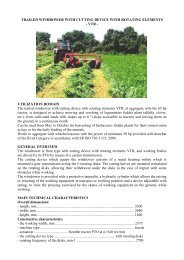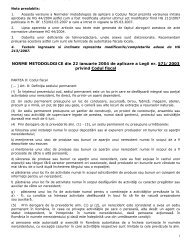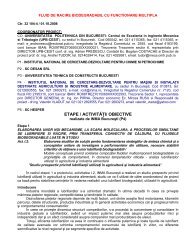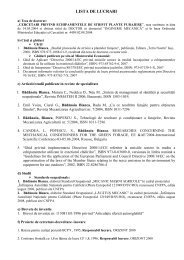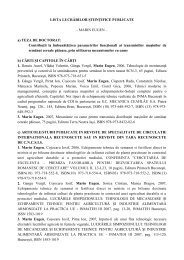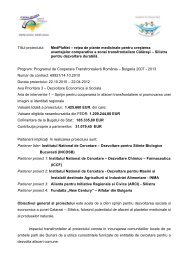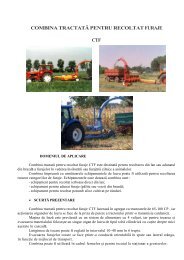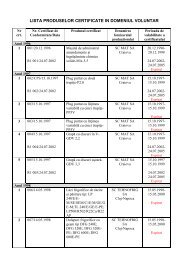january - april - Inma
january - april - Inma
january - april - Inma
Create successful ePaper yourself
Turn your PDF publications into a flip-book with our unique Google optimized e-Paper software.
Vol. 36, No.1 / 2012 INMATEH - <br />
RESULTS<br />
If we consider R as a function of a single argument, Vl,<br />
the rest being considered as constant, the extremum<br />
points (eventual optimum points) can be searched among<br />
the first derivative zeros.<br />
dR AW0<br />
k<br />
dVl K07 2<br />
Vl<br />
Solving the equation (9), it is obtained the solution:<br />
value of the unique positive extremum point (domain of<br />
definition of R as function of Vl, is included within the real<br />
positive number system). The expression of critical speed is:<br />
As for solving the optimum point problem of plowing<br />
machines, the critical speed has not only the same<br />
expression, but it is also a minimum point for forward<br />
resistance, as it is shown by figures of the first derivative.<br />
The expression of minimum value of resistance force to<br />
movement is the following:<br />
An exemple of calculation demonstrates the model<br />
utility. Let’s take the case of a tractor A-1800 -harrow GDU<br />
with roller aggregate.<br />
The harrow is equipped with 32 discs of 610 mm<br />
diameter and 610mm radius of curvature.<br />
The tilting angle of plan of discs to the forward direction<br />
is of 15 , and the working depth is 15 cm.<br />
According to [1], in this case, the area of contact<br />
surface with soil is 0.009 m 2 for each disc, totally for all the<br />
discs n<br />
i<br />
si<br />
1<br />
0 . 289 m 2 . The machine working width is B=4<br />
m. Therefore, starting from formula (7) it is got A= 0.072 m.<br />
For harrow weight together with the roller equal to 36030<br />
N, coefficient of friction f=0.4, =1500 kg/m 3 , k= 10000<br />
N/m 2 , working speed 2.45 m/s with skidding of 15.9 %<br />
(stubble), the traction force of 19618 N is obtained. If a<br />
working capacity of 3.235 ha/hour 8.986 m 2 /s) is required,<br />
then the optimum working speed would be of 2.582 m/s,<br />
while the traction force would be 19906 N.<br />
CONCLUSIONS<br />
The working process of machine of preparing the<br />
germinating bed can be improved at the working capacity<br />
required, W0, chosing the working speed (10),<br />
characterized exclusively by soil features and properties of<br />
working parts contacting the soil.<br />
This way, a minimum value for the resistance force of<br />
the machine is obtained, given by the expression (11) and<br />
implicitely the fuel consumption and other environment and<br />
technico-economic parameters are diminished.<br />
It is noticeable that the optimum speed, (10), depends<br />
only on soil features and on the properties of working parts<br />
of respective machine (by means of coefficient ).But, the<br />
optimum force, (11), depends on several parameters.<br />
For form (6) of forward resistance force function, the<br />
calculation becomes more complex and the conclusion<br />
may not be as simple as in the above case. It is possible<br />
that optimization can be performed only by numerical<br />
method.<br />
In [5], the traction efficiency is suggerated as a possible<br />
function or target functional during the optimization process.<br />
This is another possible way of optimization.<br />
24<br />
REZULTATE<br />
Dacă privim pe R ca funcţie de un singur argument, Vl,<br />
restul fiind consideraţi constanţi, se pot căuta punctele de<br />
extremum (eventuale puncte de optimum) printre zerourile<br />
derivatei întâi.<br />
0<br />
Rezolvând ecuaţia (9), se obţine soluţia: valoarea<br />
unicului punct de extremum pozitiv (domeniul de definţie al<br />
lui R ca funcţie de Vl, este inclus în mulţimea numerelor<br />
reale pozitive). Expresia vitezei critice este:<br />
k<br />
V lmin<br />
(10)<br />
2AW<br />
R 0<br />
min R( Vlmin ) fG k<br />
K07<br />
Ca şi în cazul rezolvării problemei de optimum pentru<br />
maşinile de arat, viteza critică nu numai că are aceeaşi<br />
expresie, dar este tot un punct de minimum pentru<br />
rezistenţa la înaintare, după cum arată alternanţa de<br />
semne a primei derivate. Expresia valorii minime a forţei<br />
de rezistenţă la înaintare este următoarea:<br />
(9)<br />
(11)<br />
Un exemplu de calcul demonstrează utilitatea<br />
modelului. Fie cazul unui agregat tractor A-1800 – grapă<br />
GDU echipată cu tavălug.<br />
Grapa este echipată cu 32 de discuri de diametru 610<br />
mm şi raza de curbură tot 610 mm.<br />
Unghiul de înclinare al planului discurilor faţă de direcţia de<br />
înaintare este de 15 , iar adâncimea de lucru este 15 cm.<br />
Conform [1], în acest caz aria suprafeţei de contact cu<br />
solul este 0,009 m 2 pentru fiecare disc, în total, pentru toate<br />
discurile n<br />
i<br />
si<br />
1<br />
0 , 289 m 2 . Lăţimea de lucru a maşinii este B=4<br />
m. Prin urmare, din formula (7) se obţine A= 0,072 m.<br />
Pentru greutatea grapei împreună cu tăvălugul egală cu<br />
36030 N, coeficientul de frecare f=0,4, =1500 kg/m 3 , k=<br />
10000 N/m 2 , viteza de lucru 2,45 m/s cu patinarea de 15,9<br />
% (mirişte), se obţine forţa de tracţiune cu valoarea 19618<br />
N. Dacă se cere o capacitate de lucru de 3,235 ha/oră (8,986<br />
m 2 /s), viteza optimă de lucru ar fi 2,582 m/s, caz în care forţa<br />
de tracţiune ar lua valoarea 19906 N.<br />
CONCLUZII<br />
Procesul de lucru al maşinii de pregătit patul germinativ<br />
poate fi optimizat la capacitatea de lucru necesară, W0,<br />
alegând viteza de lucru (10), caracterizată exclusiv de<br />
proprietăţle solului şi ale organelor de lucru aflate în<br />
contact cu solul.<br />
Se obţine astfel o valoare minimă pentru forţa de<br />
rezistenţă opusă de maşină, dată de expresia (11) şi<br />
implicit se minimizează consumul de combustibil precum şi<br />
alţi parametri tehnico - economici şi de mediu.<br />
Se observă că viteza optimă, (10), nu depinde decât de<br />
proprietăţile solului şi proprietăţile suprafeţelor organelor de lucru<br />
ale maşinii de pregătit patul germinativ (prin intermediul coeficientului<br />
). Forţa optimă, (11), depinde însă de mai mulţi parametri.<br />
Pentru forma (6) a funcţiei forţă de rezistenţă la<br />
înaintare, calculul se complică şi nu se ştie dacă conduce<br />
la o concluzie la fel de simplă ca în cazul de mai sus. Este<br />
posibil ca optimizarea să se poată face numai pe cale<br />
numerică.<br />
În [5] se sugerează ca posibilă funcţie sau funcţională<br />
obiectiv în procesul de optimizare, eficienţa tracţiunii.<br />
Aceasta este o altă cale posibilă de optimizare.



